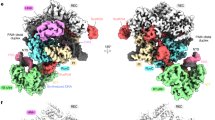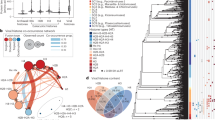Abstract
Adenoviral vector systems for gene therapy can be much improved by targeting vectors to specific cell types. This requires both the complete ablation of native adenovirus tropism and the introduction of a novel binding affinity in the viral capsid. We reasoned that these requirements could be fulfilled by deleting the entire knob domain of the adenovirus fiber protein and replacing it with two distinct moieties that provide a trimerization function for the knobless fiber and specific binding to the target cell, respectively. To test this concept, we constructed adenoviral vectors carrying knobless fibers comprising the α-helix trimerization domain from MoMuLV envelope glycoprotein. Two mimic targeting ligands, a Myc-epitope and a 6His-tag, were attached via a flexible linker peptide. The targeted knobless fiber molecules were properly expressed and imported into the nucleus of adenovirus packaging cells, where they were incorporated as functional trimers into the adenovirus capsid. Both ligands were exposed on the surface of the virion and were available for specific binding to their target molecules. Moreover, the knobless fibers mediated gene delivery into cells displaying receptors for the coupled ligand. Hence, these knobless fibers are prototype substrates for versatile addition of targeting ligands to generate truly targeted adenoviruses.
This is a preview of subscription content, access via your institution
Access options
Subscribe to this journal
Receive 12 print issues and online access
$259.00 per year
only $21.58 per issue
Buy this article
- Purchase on Springer Link
- Instant access to full article PDF
Prices may be subject to local taxes which are calculated during checkout






Similar content being viewed by others
References
Herz J, Gerard RD . Adenovirus-mediated transfer of low density lipoprotein receptor gene acutely accelerates cholesterol clearance in normal mice Proc Natl Acad Sci USA 1993 90: 2812–2816
Huard J et al. The route of administration is a major determinant of the transduction efficiency of rat tissues by adenoviral recombinants Gene Therapy 1995 2: 107–115
Louis N et al. Cell-binding domain of adenovirus serotype 2 fiber J Virol 1994 68: 4104–4106
Henry LJ et al. Characterization of the knob domain of the adenovirus type 5 fiber protein expressed in Escherichia coli J Virol 1994 68: 5239–5246
Michael SI, Hong JS, Curiel DT, Engler JA . Addition of a short peptide ligand to the adenovirus fiber protein Gene Therapy 1995 2: 660–668
Wickham TJ, Roelvink PW, Brough DE, Kovesdi I . Adenovirus targeted to heparan-containing receptors increases its gene delivery efficiency to multiple cell types Nat Biotechnol 1996 14: 1570–1573
Wickham TJ et al. Increased in vitro and in vivo gene transfer by adenovirus vectors containing chimeric fiber proteins J Virol 1997 71: 8221–8229
Yoshida Y et al. Generation of fiber-mutant recombinant adenoviruses for gene therapy of malignant glioma Hum Gene Ther 1998 9: 2503–2515
Krasnykh V et al. Characterization of an adenovirus vector containing a heterologous peptide epitope in the HI loop of the fiber knob J Virol 1998 72: 1844–1852
Dmitriev I et al. An adenovirus vector with genetically modified fibers demonstrates expanded tropism via utilization of a coxsackievirus and adenovirus receptor-independent cell entry mechanism J Virol 1998 72: 9706–9713
Roelvink PW et al. Identification of a conserved receptor-binding site on the fiber proteins of CAR-recognizing adenoviridae Science 1999 286: 1568–1571
Novelli A, Boulanger PA . Deletion analysis of functional domains in baculovirus-expressed adenovirus type 2 fiber Virology 1991 185: 365–376
Hong JS, Engler JA . Domains required for assembly of adenovirus type 2 fiber trimers J Virol 1996 70: 7071–7078
Santis G et al. Molecular determinants of adenovirus serotype 5 fibre binding to its cellular receptor CAR J Gen Virol 1999 80: 1519–1527
Cohen C, Parry DAD . α-Helical coiled coils and bundles: how to design an a-helical protein Proteins Structure Function, Genetics 1990 7: 1–15
Fass D, Harrison SC, Kim PS . Retrovirus envelope domain at 1.7 angstrom resolution Nat Struct Biol 1996 3: 465–469
Fallaux FJ et al. Characterization of 911: a new helper cell line for the titration and propagation of early region 1-deletedadenoviral vectors Hum Gene Ther 1996 7: 215–222
Graham FL, Smiley J, Russell WC, Nairn R . Characteristics of a human cell line transformed by DNA from human adenovirus type 5 J Gen Virol 1977 36: 59–74
Mitraki A et al. Unfolding studies of human adenovirus type 2 fibre trimers. Evidence for a stable domain Eur J Biochem 1999 264: 599–606
Douglas JT et al. A system for the propagation of adenoviral vectors with genetically modified receptor specificities Nat Biotechnol 1999 17: 470–475
Xia D, Henry LJ, Gerard RD, Deisenhofer J . Crystal structure of the receptor-binding domain of adenovirus type 5 fiber protein at 1.7 A resolution Structure 1994 2: 1259–1270
Fass D, Kim PS . Dissection of a retrovirus envelope protein reveals structural similarity to influenza hemagglutinin Curr Biol 1995 5: 1377–1383
van Raaij MJ, Mitraki A, Lavigne G, Cusack S . A triple beta-spiral in the adenovirus fibre shaft reveals a new structural motif for a fibrous protein Nature 1999 401: 935–938
Legrand V et al. Fiberless recombinant adenoviruses: virus maturation and infectivity in the absence of fiber J Virol 1999 73: 907–919
Von Seggern DJ, Kehler J, Endo RI, Nemerow GR . Complementation of a fibre mutant adenovirus by packaging cell lines stably expressing the adenovirus type 5 fibre protein J Gen Virol 1998 79: 1461–1468
Falgout B, Ketner G . Characterization of adenovirus particles made by deletion mutants lacking the fiber gene J Virol 1988 62: 622–625
Miyazawa N et al. Fiber swap between adenovirus subgroups B and C alters intracellular trafficking of adenovirus gene transfer vectors J Virol 1999 73: 6056–6065
Harbury PB, Zhang T, Kim PS, Alber T . A switch between two-, three-, and four-stranded coiled coils in GCN4 leucine zipper mutants Science 1993 262: 1401–1407
Harbury PB, Kim PS, Alber T . Crystal structure of an isoleucine-zipper trimer Nature 1994 371: 80–83
Toes RE et al. Protective anti-tumor immunity induced by vaccination with recombinant adenoviruses encoding multiple tumor-associated cytotoxic T lymphocyte epitopes in a string-of-beads fashion Proc Natl Acad Sci USA 1997 94: 14660–14665
He TC et al. A simplified system for generating recombinant adenoviruses Proc Natl Acad Sci USA 1998 95: 2509–2514
Chan S et al. A novel tumour marker related to the c-myc oncogene product Mol Cell Probes 1987 1: 73–82
Douglas JT et al. Targeted gene delivery by tropism-modified adenoviral vectors Nat Biotechnol 1996 14: 1574–1578
Acknowledgements
We thank David Curiel and Joanne Douglas, Gene Therapy Center UAB, Birmingham, Alabama for providing the 293.HissFv.rec cells and 1D6.14 MoAb; and Frits Fallaux, Leiden University Medical Center, The Netherlands for plasmid pMad5. This work was supported by the Netherlands Organization for Scientific Research (Spinoza Award 1997).
Author information
Authors and Affiliations
Rights and permissions
About this article
Cite this article
van Beusechem, V., van Rijswijk, A., van Es, H. et al. Recombinant adenovirus vectors with knobless fibers for targeted gene transfer. Gene Ther 7, 1940–1946 (2000). https://doi.org/10.1038/sj.gt.3301323
Received:
Accepted:
Published:
Issue Date:
DOI: https://doi.org/10.1038/sj.gt.3301323
Keywords
This article is cited by
-
The Effect of Fiber Truncations on the Stability of Adenovirus Type 5
Molecular Biotechnology (2014)
-
Targeting EGFR with metabolically biotinylated fiber-mosaic adenovirus
Gene Therapy (2007)
-
Adenovirus 5 vector genetically re-targeted by an Affibody molecule with specificity for tumor antigen HER2/neu
Cancer Gene Therapy (2007)
-
The status of gene vectors for the treatment of diabetes
Cell Biochemistry and Biophysics (2007)
-
An adenovirus vector with a chimeric fiber incorporating stabilized single chain antibody achieves targeted gene delivery
Gene Therapy (2006)



